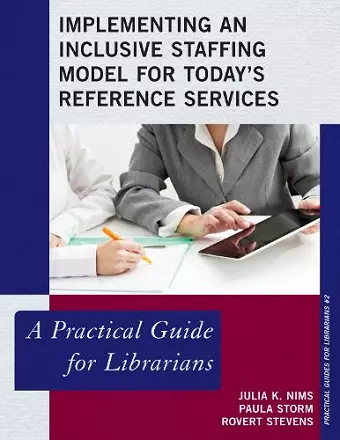Implementing an Inclusive Staffing Model for Today's Reference Services
A Practical Guide for Librarians
Robert Stevens author Julia K Nims author Paula Storm author
Format:Paperback
Publisher:Bloomsbury Publishing PLC
Published:26th Nov '13
Currently unavailable, and unfortunately no date known when it will be back

Reference service remains a core function of modern libraries. However, how and where we provide assistance has evolved with changing technologies and the shifting habits and preferences of our users. One way libraries can provide the on-demand, in-person assistance while managing and developing new services and resources that will benefit current and future users is to reconsider how their reference points and services are staffed and adopt a staff-based reference model.
The authors, staff members at Eastern Michigan University, chose to address this by implementing an inclusive reference model in which staff and student assistants are trained to answer certain levels of reference questions while working at the reference desk and at other service points. The result was that librarians became more available to work with students who needed in-depth assistance and users were able to get simple questions answered throughout the library. Similar training for all staff and student assistants who work in the library results in better service, more accurate answers, and improved interdepartmental communication.
In Implementing an Inclusive Staffing Model for Today's Reference Services, they describe step-by-step how to transition from the traditional librarian-staffed reference desk to an inclusive reference model where non-MLS personnel are equipped and empowered to answer reference questions wherever these questions might be asked. Users ask questions of staff at all service points, not just at the Reference Desk. It is vitally important that those who work at circulation, periodicals, maps, archives and other public service points be trained in how to answer certain reference questions. When this is accomplished, users who have simple questions will not have to make useless treks to the Reference Desk.
Topics covered include:
Recognizing that nearly all staff answer reference questions, but few are trained to do sodocumenting the necessity for a change in reference modelgaining buy-in from all interested parties—librarians, non-MLS staff, and administratorsdetermining the optimal staffing levelcreating training materials and schedulesmonitoring the quality of reference service supervising staffevaluating the new model using multiple methods
Additionally, each chapter contains practical resources such as checklists, forms, and sample materials, and other usable features to support readers as they implement the inclusive reference model.
The book describes in detail the process of transforming traditional reference into a model that...
[T]he bright notes [include] guidance on how best to get existing staff to participate in the changes in their work, and there are solid basic reference interview examples for training paraprofessional staff who will be on the front lines. * Library Journal *
Reference services have changed dramatically over the past several years due to technology and the ways in which user needs have changed. This also means that the way that reference services are managed is changing as well. One way that libraries have found to keep up with the needs of users is to switch to an on-demand, in-person approach to managing the reference needs of their patrons. That oftentimes means that more staff is trained at handling reference questions and more reference service points are offered. This book provides practical suggestions for implementing these changes in your references services department. It address such issues as the best approach to getting staff on board with the new model (both those with an MLS and those without), determining optimal staff numbers to have on hand, creating training materials, evaluating the quality of reference service once the switch has been made, and staff supervision considerations. The book provides sample forms, checklists, and sample materials that will save you time while implementing changes to your reference department and provide you with ideas that you may not have considered beforehand. This is a useful and worthwhile guide for any library looking to revamp their reference services department. * American Reference Books Annual *
Undertaking a project to integrate services, which involves planning, good communication, training, implementation and evaluation, is a major task. This book will prove invaluable to those undertaking such a project or considering the possibility, guiding the reader through steps in the process, and setting the scene as to why such a change is needed. . . .All of this rounds out a very clear, easy-to-read guide that might be read as a whole, or dipped into when specific information is required. * Australian Library Journal *
Honestly, this is exactly the kind of book I've wished I had over the last few years, as my library has also been exploring and experimenting with new reference service models, too. It clearly outlines both the reasons that change is needed and the practical steps libraries can take to successfully implement these changes. I really like that their plan focuses on how to determine and respond to patron needs in your own library's circumstances, making all of their suggestions potentially adaptable to libraries of any size or type. Their plan is complete from the initial data collection to assess needs to the final assessment of the new model and planning for change and ongoing improvements. This is a wonderful resource for reference librarians. -- Allison Faix, Reference Coordinator and Librarian, Kimbel Library, Coastal Carolina University
ISBN: 9780810891289
Dimensions: 277mm x 215mm x 12mm
Weight: 472g
162 pages